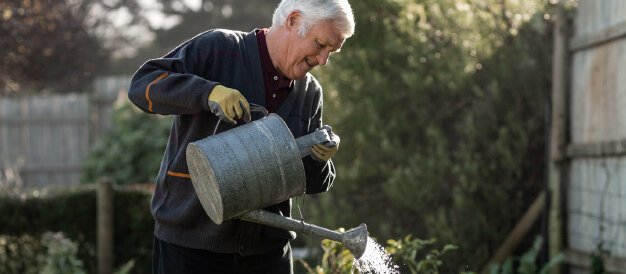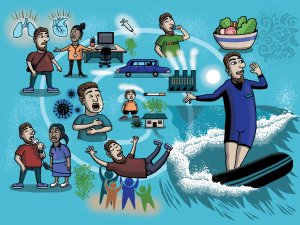Respiratory physician Lutz Beckert considers chronic obstructive pulmonary disease management, including the prevention of COPD, the importance of smoking cessation and pulmonary rehabilitation, and the lifesaving potential of addressing treatable traits. He also discusses the logic of inhaler therapy, moving from single therapy to dual and triple therapy when indicated, as well as other aspects of management
Breathing Difficulty in Seniors is a Risk to their Independence
Breathing Difficulty in Seniors is a Risk to their Independence

Along with one of the most common reasons for ambulance call outs, breathing problems are also one of the most common reasons for the activation of a medical alarm.13
The importance that seniors place on being able to live independently as they age is reflected by the majority reporting that they want to live in their own homes for as long as possible.1 Independence is an important contributor to the emotional and physical wellbeing of older adults, and remaining in their own home allows seniors to preserve a sense of security and control over their lives.2 Living at home also facilitates social connectedness with family, friends, and the community.
Children of older adults also support their parents’ desire to live at home, being concerned that the loss of independence will adversely affect the wellbeing of their parents if they have to move into an age-related residential care facility.1
Breathing difficulty is a common occurrence in older adults and is usually a symptom of an underlying health condition, most often cardiorespiratory disease.3,4
Patients presenting with acute breathing problems often experience the most distressing form of breathlessness known as “air hunger”.5 This is the sensation of needing to take in more air. Air hunger is an especially unpleasant symptom that can induce anxiety, panic, and fear.
In fact, breathing problems are one of the most common reasons for an ambulance call out.6 Older adults with breathing problems constitute a considerable proportion of emergency department case load and have a high admission rate and significant mortality.7 Exacerbations or worsening of pre-existing chronic disease account for a sizeable proportion of cases.
Many seniors presenting to emergency departments with breathing difficulties have time-sensitive diagnoses,8 emphasising the need for prompt medical attention and early diagnosis.
Delaying emergency intervention for older adults experiencing an incapacitating medical event while living at home, such as breathing difficulty or chest pain, can lead to a fatal outcome and also risks the ability of survivors to continue to live independently.9
As most older adults want to age in their home, there are assistive technologies, such as medical alarms, that can be used to support independent living. The adoption of technologies by those aged 65 years or older has grown markedly in the past decade,10 especially technologies that support an independent life.1
Medical alarms (personal emergency response systems) allow seniors to live independently and safely by providing assistance when needed, which also helps to provide their care givers with peace of mind.11,12
With a St John Medical Alarm, help is just the push of a button away, making it easy for your older patients to summon help, especially if they are unable to phone someone because they are unable to breathe or are suffering with breathing problems.
Along with one of the most common reasons for ambulance call outs, breathing problems are also one of the most common reasons for the activation of a medical alarm.13
A St John Medical Alarm offers 24/7 response and is the only medical alarm that connects directly to Hato Hone St John, providing your patients with access to round the clock monitoring when you cannot be there.
Patients have access to a free trial of up to 14 days and are easily referred through your Practice Management System via Healthlink or ERMS.
1. Aging in place in America. Research Study. PositiveAging Sourcebook. 2018. https://www.retirementlivingsourcebook.com/.
2. Wiles et al. Gerontologist. 2012;52(3): 357-66.
3. Olsson M, et al. ERJ Open Res 2022;8(1):00553-2021.
4. Smith AK, et al. J Am Geriatr Soc. 2016;64(10):2035-2041.
5. Worsham CM, et al. Chest. 2021;159(2):749-756.
6. Hato Hone St John ambulance data. 2021. https://www.stjohn.org.nz/news--info/news-articles/st-john-releases-ambulance-data-for-2021/.
7. Kelly A-M, et al. Age Ageing. 2021;50(1):252-257.
8. Kauppi W, et al. BMC Emerg Med. 2020;20(1):89.
9. Gurley RJ, et al. N Engl J Med. 1996;334(26):1710-6.
10. Pew Research Center. 2022. https://www.pewresearch.org/fact-tank/2022/01/13/share-of-those-65-and-older-who-are-tech-users-has-grown-in-the-past-decade/.
11. Stokke R, et al. J Med Internet Res. 2016;18(7):e187.
12. Karlsen C, et al. JBI Database System Rev Implement Rep. 2017;15(12): 2913-2980.
13. Hato Hone St John data on file. ProQA 2021.


